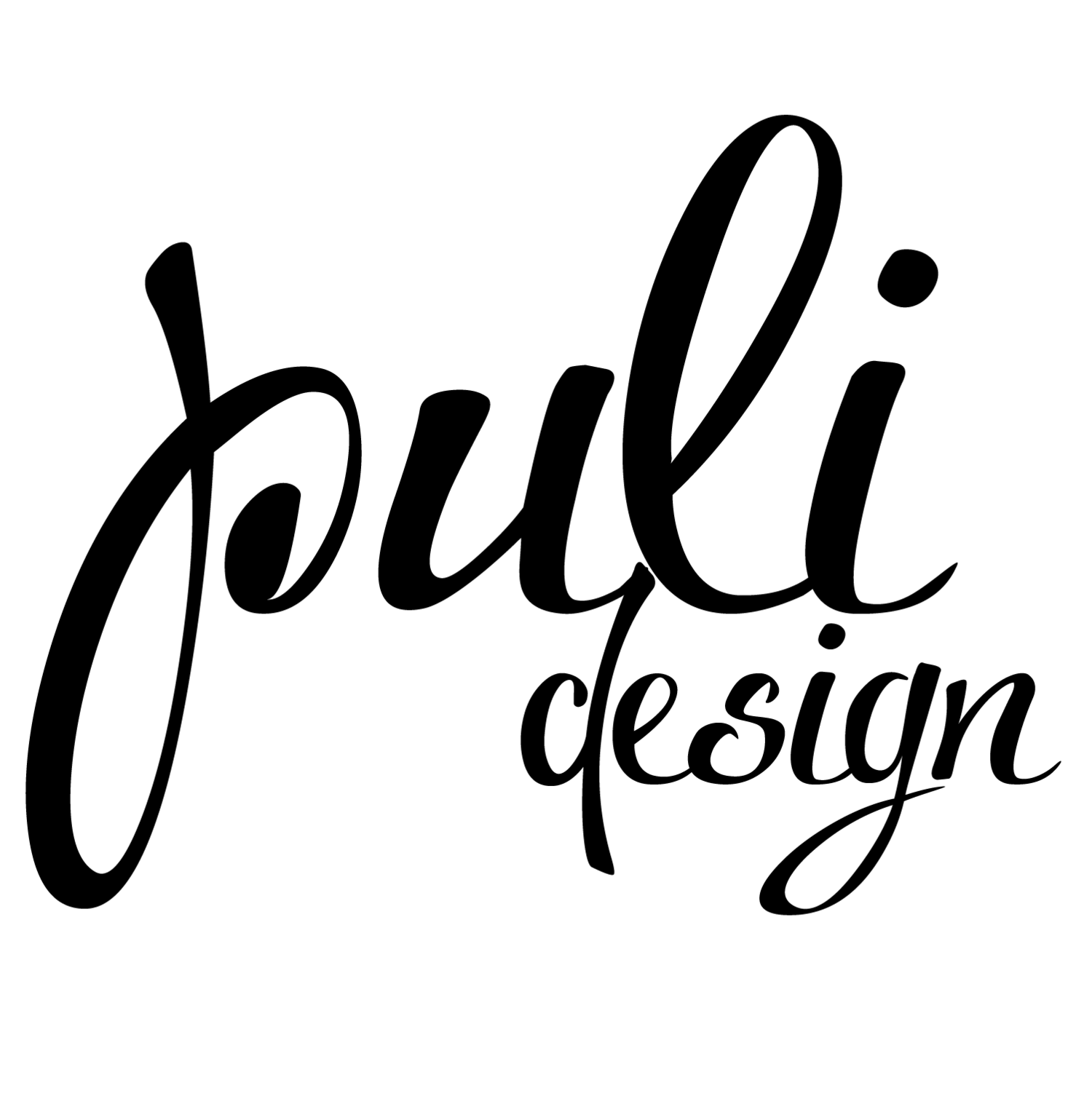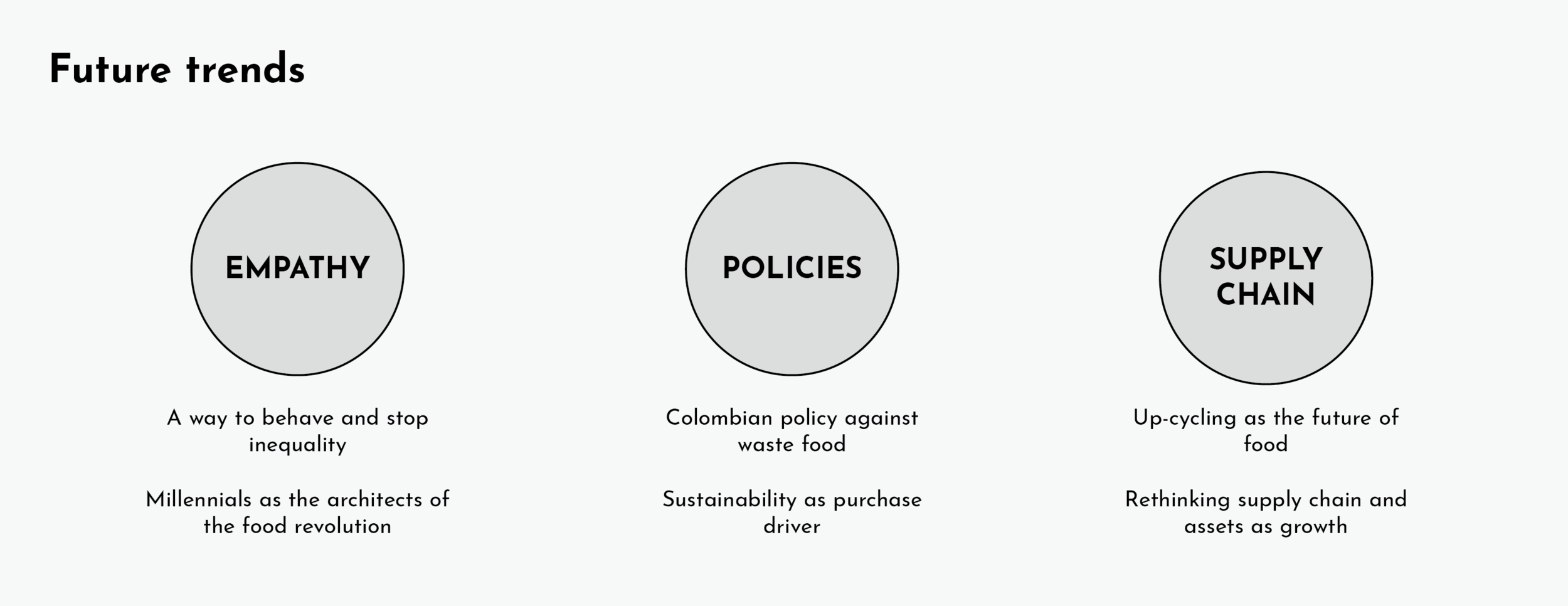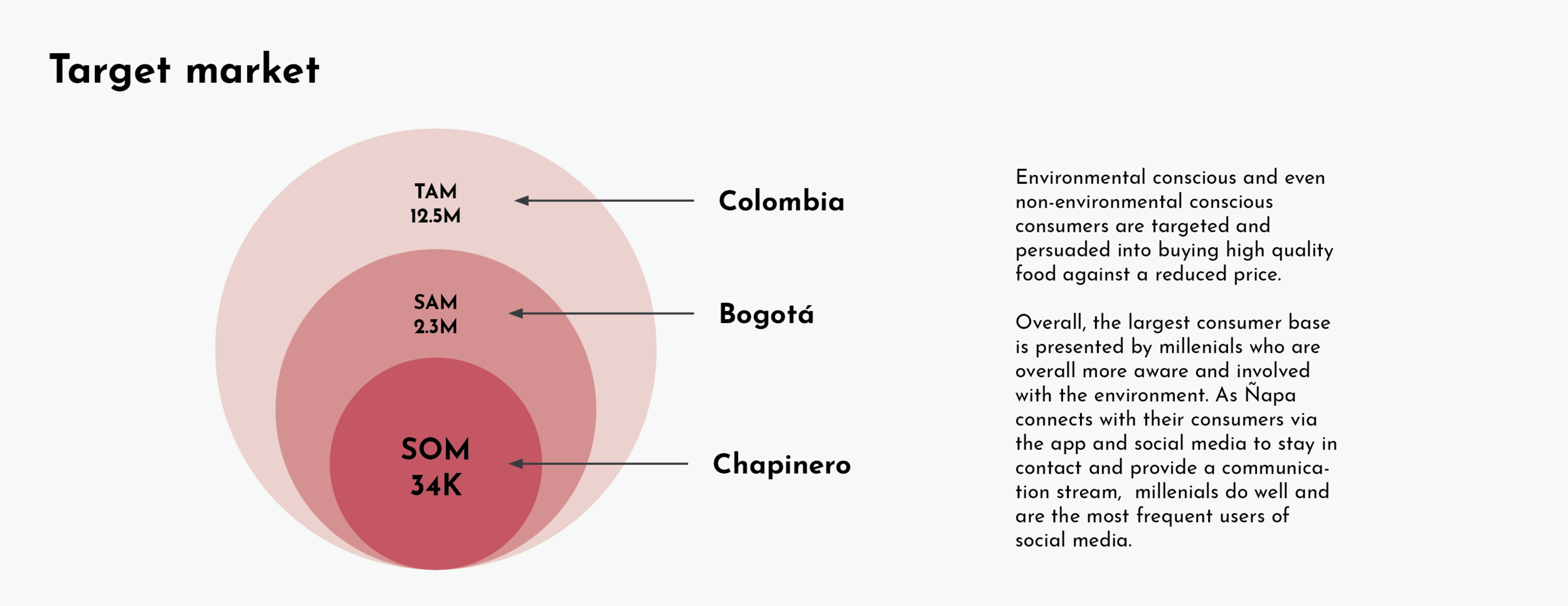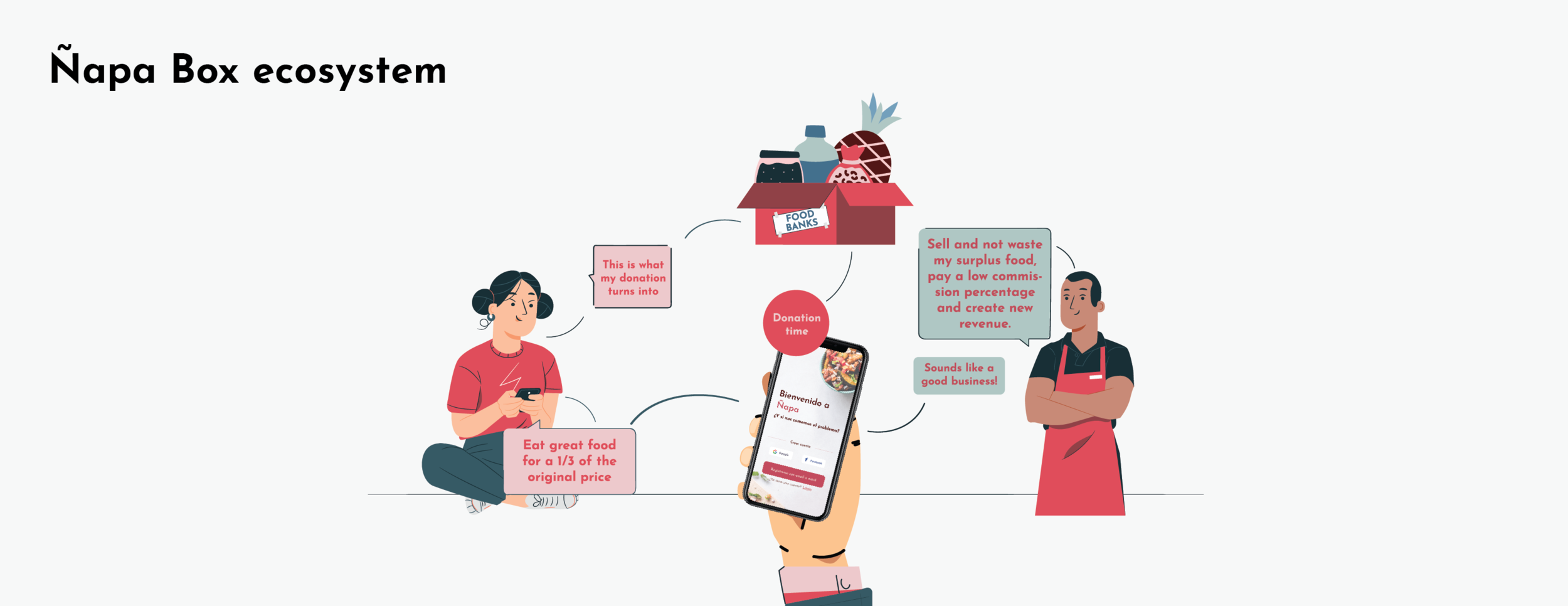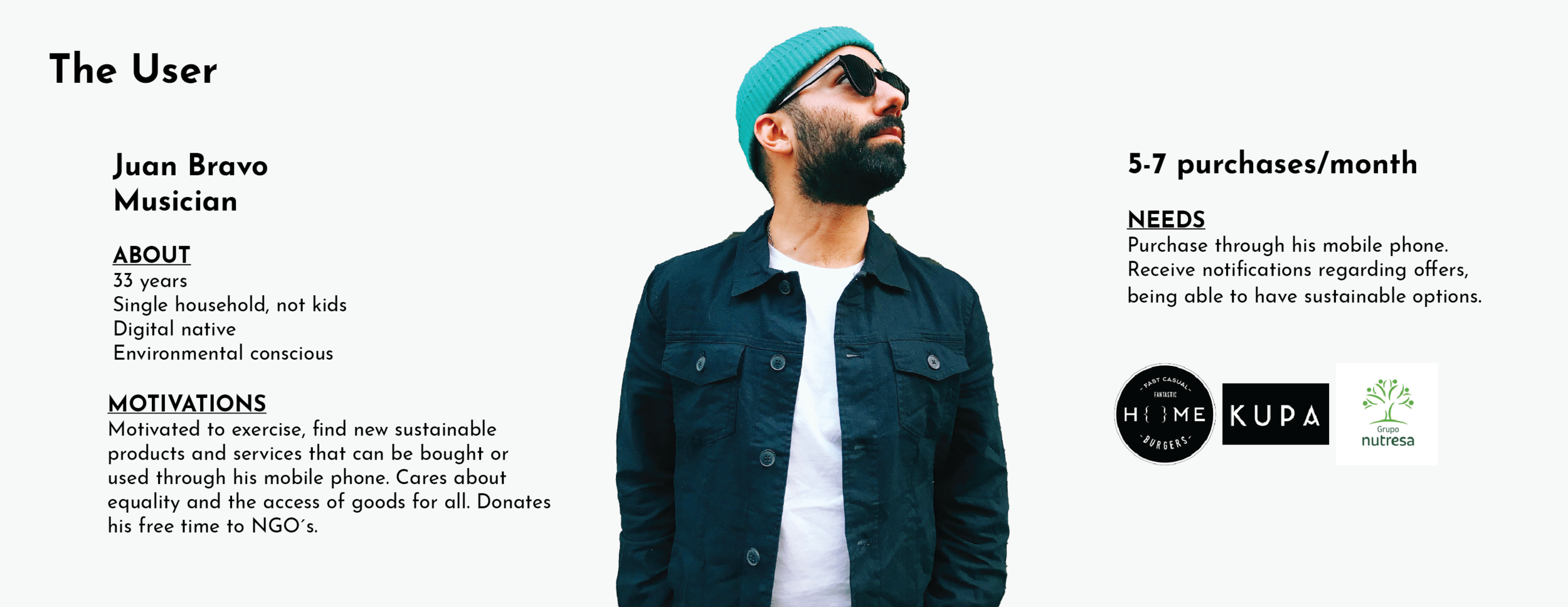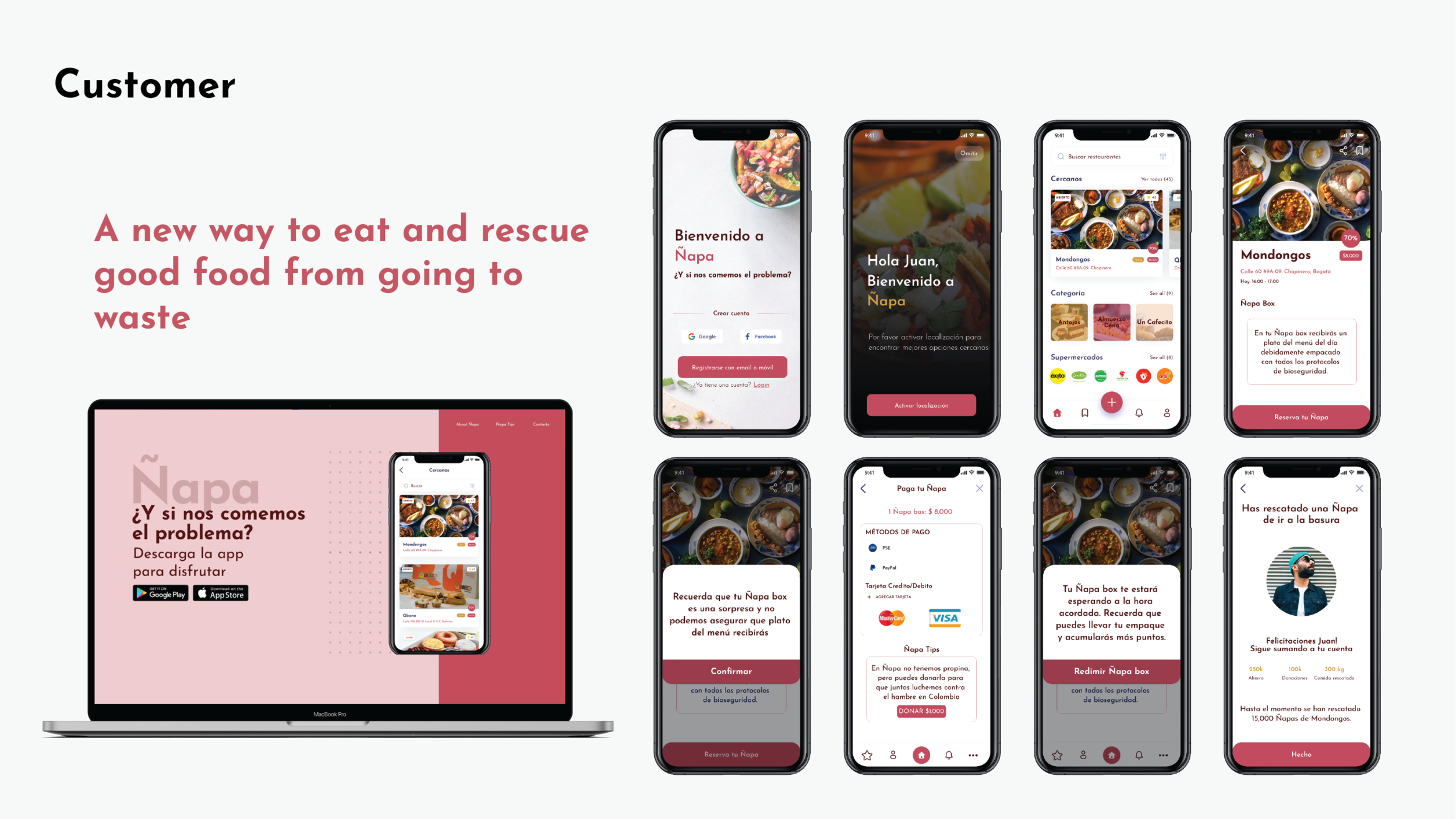Ñapa Box
Digital platform that connects food surpluses from restaurants and bakeries with environmental conscious consumers and non-environmental-conscious consumers. By providing customers a geolocalization of the nearby discounts, they purchase high-quality food as takeaway and choose their pick up time through the app can save up to 50% off the original price, and reduce potential food waste. The app encourages foodies to share their passion while contributing to a good cause by providing a donation for those who live in food insecurity instead of giving a tip, in addition create a new revenue stream for the restaurants and baker surpluses.
Role:
User research, Service Design, UX Design
Client:
Entrepreneurial project
Team:
Paulina Galeano, Strategic & Business Designer
Date & Place:
Dec 2020 - March 2021. Madrid, Spain.
Project Overview
Context
Taking into consideration the present times we are living, and the uncertainty that the future holds, we can say that society, as we know it, has been forced to change in many different aspects. As innovators and designers, we have an obligation to dream in a different future. Now, it is the right moment to explore in-depth the current business models, and its necessity to adapt to the new circumstances.
The moment to propose new sustainable ways of living, and being able to prototype new products that will help us to build a better future. This portrays a new era where the business model becomes the new design brief of the future. This environment has also amplified the need to consider not only how to address the customer needs, but also how to capture value, from providing new products and services.
We need to propose new emerging solutions to the new realities that we are facing as a society. We must be prepared to give sustainable solutions as a necessity to raise the future. Design is increasingly being viewed as a vital and important resource. There are so many opportunities in which we could make a difference, use design as a vehicle for change.
Challenge
To develop an own initiative relevant to this time frame (November 2021), that can be a business model, a new service, or a new tangible product, that has a competitive advantage based on the fact that it is designed for the “new normality”.
My Role:
My role in the project was as Strategic & Business Designer. This was an entrepreneurial project and leading all the phases based on Human-Centred Design for collaboratively design the experimentations and interventions.
I designed and facilitate the online workshops, planned and conducted researcher, analyze the data and communicated the insights, and conceptualized and crafted the proposal. I also was in charge of creating the end-to-end service and the complete business model proposal.
Design Process
This was my first project alone during the pandemic, already in lockdown in Madrid. I embarked on this project with a lot of enthusiasm to learn more on how to enhance individuals and leaders to become more sustainable.
I need to start by understanding the trends and changes society, business and consumers will face and foresighting a new future based on these trends.
I used a mixed methodology using Double Diamond Theory, Lean Start-up, and Lean Branding. I structured a design process of 4 months that incorporate the key phases of Discovery, Definition, Design and Delivery to guide me through the research and drive to find meaningful insights from users to help me come out with an MVP around the new mobile experience of food surpluses.
This project was created to be implemented in Colombia therefore all the data and the designs are based on Colombia research.
The Future Scenario
A very divergent approach was taken in order to generate as many ideas as possible. In addition to general product research, I conducted several foresight sessions and future trends analysis to approach the final proposal.
The aim was to create a product/service that was both easy to use and aesthetically pleasing. Next to examining the feasibility and product design, I focused on the development of a user-centered service and a viable business model. Through the analysis, I came up with a service that address food surpluses as a new revenue stream.
Colombia, April 5th 2022. The COVID-19 pandemic has passed, the vaccine has been spread throughout the world to all humankind. One of the most serious consequences of the pandemic is the increase in the already high levels of food surpluses, which do not reach the 8 million people that could be fed with the wasted food.
People are returning, though at a slow pace, to social life. Despite this, restaurants, bakeries and hotels now have more food surpluses than ever before.
In addition, a new law has been enacted in Colombia regarding up-cycling food in the supply chain, whereby food producers are allowed to add value to surplus-products that might otherwise land in the trash bin, thus turning into waste.
The Opportunity
I analyzed and synthesized all the data collected from primary and secondary research, trend analysis and I start defining the design opportunities for the project. By understanding the users’ needs I was able to create the user journeys for the MVP. This information allows us to define the route in consequence of the established objectives.
The first step was to understand the business objectives, as well as the needs and desires of the different users who will be using the platform. I defined an initial Business Model Canvas and Lean Startup Canvas, which helped me to put the objectives of this project in context.
I also looked at which products and services were currently in the market to see references for behavioural change. I downloaded and used more than five apps to better understand the experience and the value proposition they were offering.
I translated the insights into “How might we..?” to reframe the challenge, set priorities and clear guidelines for the design phase.
Reduce a significant percentage of the food waste generated annually in Colombia, while creating a new revenue stream for surplus food in establishments such as restaurants, bakeries, among others.
Ñapa Box
Digital platform that connects food surpluses from restaurants and bakeries with environmental conscious consumers and non-environmental-conscious consumers.
By providing customers a geolocalization of the nearby discounts, they purchase high-quality food as takeaway and choose their pick up time through the app can save up to 50% off the original price, and reduce potential food waste.
The app encourages foodies to share their passion while contributing to a good cause by providing a donation for those who live in food insecurity instead of giving a tip, in addition create a new revenue stream for the restaurants and baker surpluses.
The Business
The Business Model
After combining the analysis from the business model canvas, the lean startup canvas and the competitor analysis; I was able to establish the business model that would apply to Ñapa.
Ñapa is a two-sided marketplace that charge 20% commission for each transaction. From one side we have our customers, the millennials, who can buy great food with a discount up to 70% of the regular price, and on the other side we have our suppliers, restaurants and bakeries, who upload their offer of surpluses and create a new revenue stream.
The Value Proposition
Thinking on the users and suppliers of the service, I created the VP for each of the actors involve in the service by asking myself who are those actors and what they get from the business?
Customer VP: What if we could eat the problem? - Eat great food for less money
Food suppliers VP: What if we could profit from this? - Waste becoming revenue
The Go-To-Market
As the business is a two-sided marketplace which means I need to have both sides of the business at the same time, I encountered with the chicken and the egg paradox.
I decided to go with Food Suppliers side and focus in their VP - Waste becoming revenue- to start running the virtuous circle by creating liquidity in a small segment of the market.
Marketing Strategy
For the marketing strategy I structure a plan for the social media communication with the actos involved. I plan 3 strategies:
Product based content: what, how, where can I get Ñapa?
Educational based content: food waste tips and tricks from experts
Company based content: news and blogs
